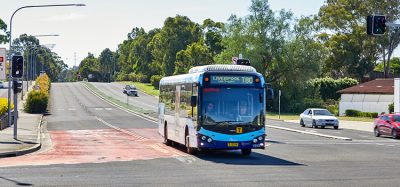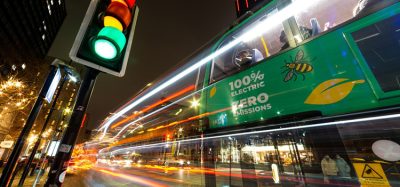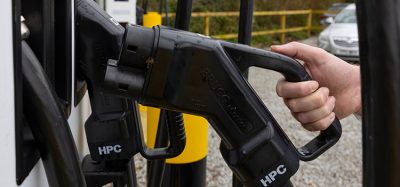Bridging transport gaps with on-demand and shared mobility
- Like
- Digg
- Del
- Tumblr
- VKontakte
- Buffer
- Love This
- Odnoklassniki
- Meneame
- Blogger
- Amazon
- Yahoo Mail
- Gmail
- AOL
- Newsvine
- HackerNews
- Evernote
- MySpace
- Mail.ru
- Viadeo
- Line
- Comments
- Yummly
- SMS
- Viber
- Telegram
- Subscribe
- Skype
- Facebook Messenger
- Kakao
- LiveJournal
- Yammer
- Edgar
- Fintel
- Mix
- Instapaper
- Copy Link
Posted: 10 March 2023 | Intelligent Transport | No comments yet
On-demand and shared mobility – an umbrella term that covers many different forms of transport. From ride- and car-sharing, to Demand-Responsive Transport, to e-scooters and e-bikes, there are many on-demand and shared options that are available to a passenger. Heralded both as a way to fill first- and last-mile transport gaps, as well as to encourage people to leave their private cars at home, on-demand and shared mobility has an endless number of opportunities to contribute to the wider development of the public transport industry.
This ‘roundtable’ brings together key industry personnel and those passionate about sharing their opinions on on-demand and shared mobility to discuss how these newer forms of transport can improve the passenger experience, support efforts to deliver a more sustainable transport industry and contribute to the development of MaaS, as well as to consider what the future may look like for new mobility.


Participants
  |
  |
  |
|
Luke Marion Interim Managing Director of The Go-Ahead Group’s Oxford Bus Company |
Dmitri Pivovarov Vice President for Rentals |
Cormac Quinn Regional Manager – UK & Ireland at Neuron Mobility |
How has the on-demand and shared mobility industry changed over the course of the last five years?


The COVID-19 pandemic, however, took the wind out of that concept. Shared private hire hasn’t set the world alight and things have since moved in a different direction.
The action is now around buses and the question tends to be, “How can we plug in an on-demand service so that it fits within a local public transport network?” Operators are working in partnership with local authorities to identify specific gaps in commercial, timetabled bus or rail services which can be filled using on-demand vehicles.
A £20 million rural mobility fund set up by the Department for Transport (DfT) has gone into pilot on-demand schemes. There’s been a lot more local authority interest.
A good example is JustGo in the Scunthorpe area, which we began operating in 2020 with funding from North Lincolnshire Council to partially replace parts of the tendered bus network. And we’ve just begun another demand-responsive service, PickMeUp, in localities and suburban areas around High Wycombe with support from Buckinghamshire County Council.


This is happening for a number of reasons. Micro-mobility gains popularity because it addresses very specific mobility needs; i.e., short in-town trips. Scooters and e-bikes address this need more efficiently than a private car. Micro-mobility is also a great addition to public transportation as it works as a last-mile solution, especially in the areas that lack enough public transportation connections. On top of that, micro-mobility is a valid addition to mobility hubs and conveniently connects bus or train stations with a final destination. In order to help people to shift from their private cars to micro-mobility, a proper density of scooters and e-bikes is necessary so that people can rely on sustainable micro-mobility when they plan their trips around the city.
Another factor is that the products themselves are getting better. New technologies have played an increasingly important role in delivering the best possible experience for shared mobility users, as well as serving the needs of cities. Over the past few months, we have introduced several new features on our scooters, including an artificial intelligence (AI) parking system to help to improve users’ parking habits; a patent-pending tandem riding prevention system to tackle the problem of more than one person riding a scooter (a frequent cause of accidents); and a cognitive reaction test, which is an in-app solution to prevent intoxicated riding.
The rise of shared mobility is also a part of broader socio-economic changes where younger generations, but not only them, prefer shared options over purchasing goods, as it provides more flexibility and helps them to save money.


Like any emerging technology, the rapid rise of rental e-scooters has led to great debate about how to best manage them. Operators and cities are now making a conscious effort to improve and refine the regulations and technology that govern e-scooter schemes, in an effort to avoid the problematic free-for-alls that accompanied the early spread of the vehicles elsewhere in the world. Increasingly, cities are choosing to limit the number of micro-mobility operators by awarding long-term contracts to the best operators which prioritise managing e-scooters and e-bikes in a sustainable and responsible way.
Neuron Mobility was founded in 2016 and now operates around the world, in four different countries and 26 cities. Our approach to operating e-scooter schemes places a strong focus on safety, working with cities and sustainability. We excel in regulated markets where we have to be very dynamic and flexible by tweaking and adjusting the model to whatever demands are required in each country, which can sometimes differ from city to city. Despite the challenges that come with this process, it is very important to us as a safety-focused company, and we strongly support regulations that enhance safety.
In what way do on-demand and shared mobility options contribute to an improved passenger experience?


For an orbital route around the outskirts of a town, or between two villages, you might previously have taken a bus into a bus station, waited 10 minutes to change and then got on a different route. On-demand services put the power in your hands to travel directly, when you want.
From an operator’s perspective, they provide more flexibility – if a lot of people on a particular housing estate want to go to a school or college in the morning, we can run that journey at peak times and then redeploy the vehicle where there’s more demand in the middle of the day.
And, in terms of accessibility, it means improvements, too – minibus-sized vehicles used for shared services tend to be optimised for wheelchair users. There’s no need for complicated lifting devices that you tend to need for taxis.


Rather than being stuck in traffic, scooters and e-bikes will get you from A to B in a quick and easy manner. A good density of vehicles makes them even more convenient, as they are easier to find.
On top of that, they do not add to air pollution problems and are silent, enhancing the quality of life for city dwellers as they help to tackle air pollution and noise issues.
They’re also affordable, and users don’t need to bear the significant cost of purchasing a car and everything that goes along with that (tax, insurance, etc.).
For us, we believe that cities need to be built around people, not private cars. That’s why our mission is to make cities more people-friendly and less private car oriented by offering affordable and convenient shared mobility alternatives. A multimodal combination of ride‑hailing, car-sharing and micro-mobility, which addresses different mobility needs, is a crucial factor in helping people to shift away from private cars.


While the experience of our users is obviously very important to us, it is also crucial that we take into account the experience of all road users. We have partnered with the Royal Society for the Prevention of Accidents (RoSPA), as well as leading sight loss charities – the Royal National Institute of Blind People (RNIB) and the Thomas Pocklington Trust (TPT) – to understand community perspectives around e-scooter use. These partnerships have highlighted how the responsible use of e-scooters – including good parking, not riding on pavements and maintaining a safe distance from other road users – can improve safety outcomes and offer reassurance to the entire community.
We also know that e-scooters can provide a wealth of benefits beyond just getting from A to B. Data from our latest report, titled ‘Shared Rides, Shared Wealth’, highlights how e-scooters are helping to boost local economies and revive the high street, which is particularly important in the wake of the COVID-19 pandemic. Our rental e-scooters have been responsible for injecting an estimated £14.9 million a year into local economies in the UK.
Ninety-seven per cent of our users in the UK believe that Neuron has created a positive impact for their city, which clearly shows that we are on the right track, but our work doesn’t stop here and we are committed to helping our towns and cities thrive in the long term.
Do you think that on-demand and shared mobility will be the key to operating efficient, effective and successful MaaS schemes as they become more commonplace?


Schemes such as these need to be introduced alongside measures such as workplace parking levies and bus priority schemes to build the case for public transport and encourage mode switching. And we also need to re-imagine places where people change modes of transport – Go-Ahead has done a lot of work with Arup on how to create attractive, appealing mobility hubs, where you can switch between bikes, buses, electric vehicles and shared mobility.
We’re also aiming to integrate on-demand services as seamlessly as possible into scheduled public transport networks. In Buckinghamshire, for example, for any given journey, our Carousel Buses app will advise you on whether your best option is a scheduled bus or our on-demand PickMeUp service. And you can book the on-demand service so that it arrives at a bus stop just in time to catch your connection.
Looking ahead, through ticketing will be coming soon, allowing you to book a combined on-demand journey with a scheduled bus or rail journey. And, in the wake of the National Bus Strategy, there’s very much a trend towards co-ordination – competing bus operators know that they need to give the public combined information about their different services.


In 2021, Bolt partnered with the Institute of Transport Economics (TØI) in Norway in a research project that showed that in-app encouragement increased chances of Bolt users choosing a scooter over ride-hailing for shorter distances of up to 3km by 60 per cent. This is a direct example of how multimodal apps like Bolt can have a positive impact on cities. By shifting users away from cars and towards micro-mobility for shorter journeys, we can tackle issues that many cities struggle with, such as congestion, pollution and the city landscape being occupied by too many idle cars and car infrastructure.
It all comes down to making sure that a scooter is always near to the user. Where shared mobility options offered by Bolt were plentiful, the shift in mobility habits was higher. When shared scooter numbers were capped by local regulation, the shift in mobility habits was consistently weaker.
Integrating the Bolt app into MaaS projects is not indispensable, as micro-mobility works well organically without integrations, too. However, we are always open to these kinds of partnerships. Scooters and e-bikes help to fill a gap in the local public transport infrastructure by improving connectivity to areas that have a weaker public transportation network. Importantly, it can also incentivise people to use public transport. For example, in Portugal, Bolt partnered with the Navigante card in Lisbon to offer Bolt users 20 minutes of daily e-bike or scooter usage for €15 a month.
How do these newer forms of mobility contribute to the sustainable development of the public transport industry?


In the UK, the government’s Climate Change Committee reckons that 17 per cent of car mileage needs to be switched to public transport, walking or cycling by 2050.
On-demand services are vital in delivering that modal shift – you can’t cover absolutely all territory using fixed bus or rail routes, and we need to be flexible in meeting peoples’ needs. Active travel – walking and cycling – are hugely important, but they’re not necessarily an option for every journey, or for every individual.


It is also important for us to look at our own carbon footprint and ensure that our services are as sustainable as possible. Our current operations are carbon neutral, and while this means that every ride that we offer has no net emissions associated with it, we can do better for our cities, our riders and our environment. In 2021, Neuron set out an ambitious sustainability strategy, developed in close consultation with our leadership and Neuron teams around the globe. By understanding the specific challenges that are faced in each market and aligning resources to fill these gaps, as well as meet leadership objectives, we finished the year with a strong focus on sustainability across all of our launched markets and a clear path for soon-to-launch cities.
In 2022, we announced our commitment to achieve Carbon Negative status for our global operations by 2025. This followed on from Neuron securing Carbon Neutral certification1 in 2021 and signing up to The Climate Pledge2 to reach Net Zero by 2040.
What do you think the future of on-demand and shared mobility will look like, and will these newer forms of mobility become an even more vital part of the transport system?


Those semi-urban areas tend to have benefited from the work from home trend post-COVID-19, with new local shops, cafes and services popping up because people are going into city centres a bit less.
On-demand buses aren’t going to replace conventional, well used bus routes going into and out of town. And it’s a bit optimistic to see them as solutions for deeply rural areas, unless you’ve got local authorities with deep pockets.
There’s a bright future ahead for shared mobility – there are going to be lots of different variations on this theme, but the one thing that they’ll all have in common is that they’re more sustainable than cars or taxis.


While micro-mobility is still quite a new industry, it has already attracted millions of users. In order to push the industry further and shift more people from private cars to micro-mobility, we need to address one of the issues that people care most about when it comes to micro-mobility – safety.
From the moment that we first launched scooters in 2018, providing a safe micro-mobility service has always been a priority. That’s why we were proud to decrease the number of scooter accidents by 12 per cent and injuries by 26 per cent in 2021, despite the number of rides completed on our scooters increasing five times compared to the previous year. One reason for this is our beginner’s mode. An industry first, this option limits a scooter’s speed to 15 km/h to make sure that new users have the option to learn riding in a safe environment.
We also believe that city-operator partnerships will become increasingly important. We are always happy to work with our city partners to deliver the best solutions to address their needs precisely. However, growth of micro-mobility will require better infrastructure to accommodate the service. This means more bike paths and dedicated parking spaces to help users to park vehicles correctly after they finish their ride. Operators can also help with this. At Bolt, we have capabilities to support cities in setting up the right parking infrastructure and introduced charging docks for scooters and for e-bikes that are developed in-house, which increases vehicle availability for users and addresses parking issues for cities. It also makes our scooters even more sustainable. The charging docks that we have installed in Tallinn allow us to avoid the creation of 300kg carbon dioxide per month. The docks have already been installed in Estonia, Lithuania and Portugal. We also invite other cities to discuss their mobility needs, and we are happy to provide them with the micro-mobility framework adapted to their individual needs.


The technology powering e-scooters will no doubt become more advanced over time, with new and better features being developed in response to feedback and experience gained by operators that are running e-scooter programmes, as well as the demands of transport teams in cities and towns.
Beyond innovation, it is also important that e-scooter programmes are designed thoughtfully, with a view to emphasise safety while also making it easy for people to switch from using cars, and that the e-scooters are well integrated into cities in the best possible way.
For Neuron, innovation will always be linked to improving safety, first and foremost. Investment in safety innovation has been a driving force behind Neuron’s success and has allowed us to address the specific safety needs of each community where we operate. We made a decision early in the company’s history to design our own e-scooters specifically for renting and safety.
We have a constant pipeline of new safety features that we are developing and testing, and we are proud of our long list of industry firsts. In 2018, we launched the first swappable e-scooter battery for greener operations. In the same year, we also launched a full suite of geofencing features to control where and how our e-scooters are ridden.
In early 2020, we introduced the first app-controlled helmet lock, which integrates a helmet to every e-scooter. And, in 2021, Neuron launched the trial of our new technology, including the ‘e-scooter brain’3, which uses smart sensors and AI to detect and respond to dangerous riding in real time and to offer unprecedented control over how vehicles are ridden and parked. The technology trial, which is ongoing in Slough, will see successful features rolled out across Neuron’s fleet internationally in the future.
As we look to the future, we see the proper management of e-scooter schemes as an important factor of ensuring safe, sustainable and socially desirable operations.
This will help to secure the buy-in of the wider community and ensure that both riders and non-riders can experience the benefits of this new form of mobility while minimising any potential negative impacts.
References
- https://www.rideneuron.com/neuron-celebrates-earth-day-2021-with-greenrider-challenge-and-carbon-neutral-certification/
- https://www.rideneuron.com/neuron-joins-the-climate-pledge-to-achieve-net-zero-target-by-2040/
- https://www.rideneuron.com/neuron-introduces-the-worlds-most-sophisticated-e-scooter-with-global-technology-trial/
Related topics
Accessibility, COVID-19, Journey Planning, Mobility Services, On-Demand Transport, Passenger Accessibility, Passenger Experience, Sustainable Urban Transport
Issue
Issue 4 2022
Related modes
Bikes & Scooters, Bus & Coach
Related organisations
Bolt, Neuron Mobility, Oxford Bus Company, The Go-Ahead Group
Related people
Cormac Quinn, Dmitri Pivovarov, Luke Marion








